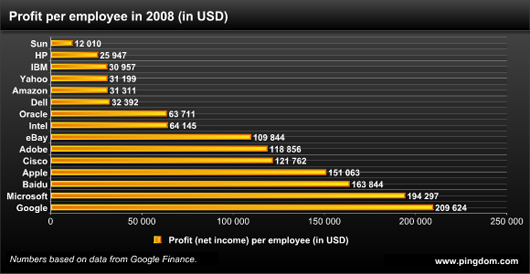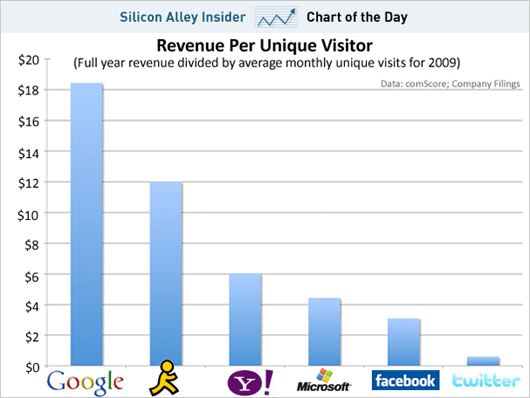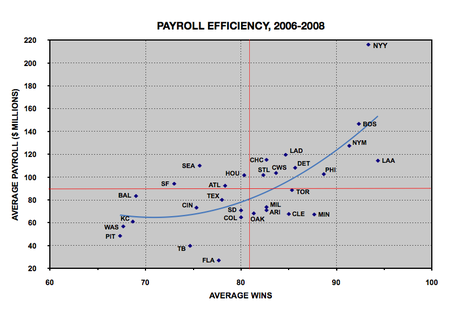A couple months back, we took a look at how tech companies stack up when measured by revenue per employee. Here are some other links (some recent, some older) that discuss payroll and efficiency:
Royal Pingdom reports Google had $209,624 in profit per employee in 2008, beating out Microsoft, Apple, Intel and IBM.

According to an ‘08 article from The Financial Times, Nintendo produced more than $1.6 million per employee—more than investment bank Goldman Sachs’ $1.24 million per employee during 2007.
CNBC looked at how much revenue S&P 500 companies generated per employee over a fiscal year.
Automobiles & Components
Industry Leader: Harley Davidson (HOG)
Annual revenue per employee: $641,612
Annual profit per employee: $62,848
Employees: 9,300Industry Leader: Amazon.com (AMZN)
Annual revenue per employee: $962,319
Annual profit per employee: $33,237
Employees: 20,600
Business Insider illustrates the value of a unique visitor for several different types of web properties.

“The Craigslist Anomaly” is Michael Slater’s search for lessons from the site’s success.
Replicating this success is not, of course, something that any new site could rationally aspire to do. Perhaps the central reason for craigslist’s great success is that they took a function that was being done offline (classified ads) but could be better done online, and translated it quite simply to to online world. Their goals were modest, and they weren’t trying to build a huge franchise—they were simply trying to solve a problem. Ironically, this led to a huge and powerful franchise.
SI.com looks at the baseball teams that got the most bang for their buck over the last decade.
Florida took advantage of the system over the past decade. The Marlins found a way to spend as little as possible and win just enough—well, maybe. They did win one world championship in the decade but gave their fans only one other pennant race. Here’s a good question for fans: would you take one world championship every decade if it meant punting eight of the other nine years?
Another baseball piece: In “MLB Payroll Efficiency,” Purple Row attempts to correlate number of wins with year-end payroll over a three-year period.


Scott
on 17 Jun 10Shows that Google’s decision to have basically zero customer service pays off in at least one metric.
James
on 17 Jun 10And what of 37signals. You guys talk it up good but what is your evidence?
Cem Vardar
on 17 Jun 10Interesting numbers to look at but from economical sense (think profit maximizing) they are not measure of efficiency. IMO better way to think about it is the marginal value of an additional employee. So if you add another employee to craigslist (or to any other company), and if he/she brings more than he/shes costs than from profit maximizing point of view craigslist is not efficient.
Tom G
on 17 Jun 10These greedy bastards have been way overcharging us.
I wonder how many of these profitable employees are exploited (probably foreign) workers…
Baseball Fan
on 17 Jun 10Interesting to see the huge difference in numbers between the Cubs and White Sox. I was at the Cubs – Sox game Sunday night. Wrigley is the ultimate baseball fantasyland. Truly a wonderful place. If you’ve never been to a night game there, do yourself a favor and go. When the fading light hits that place it is magic. But the Cubs will NEVER win it all there.
Jake
on 18 Jun 10John Gruber should use this thread as an example of why web comments suck. We’ve got two insightful comments so far, and the others are: snarky anti-Google, I’m-entitled-to-your-P&L-sheet, and anti-capitalism. Way to go, Internet!
street
on 19 Jun 10i wonder if apple’s numbers include the foxconn workers who make about $170 a month?
Oisin Prendiville
on 19 Jun 10If you’re making US$200,000+ profit per employee you seriously need to start paying people who work for you better. If you advocate keeping your business small, and I do, it also stands to reason that the people you do bring into the fold should be making their fair share and not just raking it in for the few at the top.
Raj
on 21 Jun 10Anyone who solves a painful problem in a simple and effective way is sure to succeed. Google, Craigslist and Amazon I believe are such companies.
As you guys often mention, the basics can never be compromised. Speed, usefulness of information and quality of information. Thats what these companies did and hence they didnt need a great PR program/marketing lingo or brand awareness – IMHO
Derek Scruggs
on 22 Jun 10Oslin, in the context of Google, what is a “fair share?” Is the guy who works in one of the data centers contributing as much as the guys who write the search algorithm? As the inventor of Adsense? What if all Google employees make, on average, 10% better than their peers? Are they not getting their “fair share?”
Richard
on 22 Jun 10Great Post. Entrepreneurs have to be excellent managers of resources - human, financial, informational, technological, material and time. If you are organized, savvy with finances, can manage inventory, schedules, and operation - opening your own business might be a good solution for you. If you are interested in some online courses to help you get started I found a great non-profit that has been providing online education to adult jobseekers in 60 IT certifications in (Microsoft,Cisco, Oracle, Sun, A+, Net+, Security+ etc.) and Business (including Project Management certification) at www.nefuniversity.org. You can find the link on the home page at the top titled Small Business.
This discussion is closed.